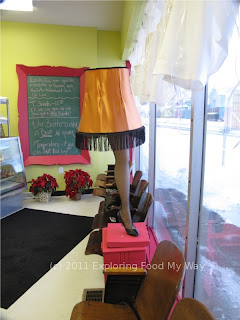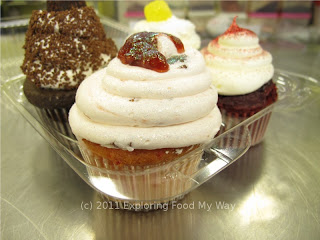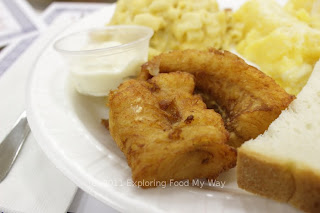While one could certainly do dim sum by him or herself, the experience is greatly enhanced when you share it with others. Thus, being inspired by the Top Chef episode, I contacted a number of foodie friends, and on a recent Sunday around noon, five others joined me to partake of a meal at a Cleveland dim sum stalwart, Li Wah Restaurant. Located inside the Asia Plaza building, it was located at 2999 Payne Avenue, Cleveland, OH 44114 and can be reached at 216-696-6556. Parking was available in a lot outside the building.
Here was a shot of the corner of the Asia Plaza, announcing Li Wah's presence:

Once inside the building's main doors, the entrance to Li Wah just off to the left. When we arrived, the restaurant was about two-thirds full, a sign that the kitchen was cranking out fresh dim sum dishes almost constantly. After being seated at a table right next to the roasted meats carving station (what a sight THAT was to behold), we started the meal by participating in the associated dim sum tradition of yum cha, or "drinking tea":

Fellow food blogger Nancy from Fun Playing With Food had joined us for our meal today and since she has an excellent memory for the actual names of the dishes we had, I consulted her well-written blog entry about our meal to verify the names. However, you don't have to know the actual name for each dish as the menu provided to us gave it to us by description as well (e.g., Steamed BBQ Bun). That being said, let the food fest begin!
The first dish on the table was the Eggplant Sandwiches:

Slices of eggplant had been stuffed with pork and shrimp, breaded and then fried in a wok. Delicious without being oily, I can see why these were a favorite of Nancy's (who had identified them on the dim sum cart).
Next up were the Baked Coconut Buns topped with sesame seeds:

The filling was smooth and custard-esque without being too loose. The coconut flavor was present and while it was a little sweet, it stayed safely away from being dessert territory.
Next up were steamed rice-paper wrapped shrimp dumplings:
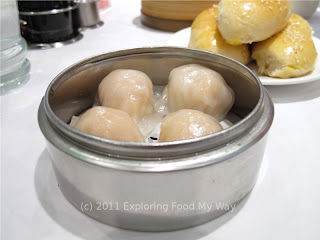
The actual name for each type of dim sum can be dependent on the wrapper, the filling, and the method of cooking (steaming versus frying). Alter one of these three, and it can end up having a brand new name. These dumplings were tender and had great shrimp flavor.
Prepare yourself, gentle reader. As the chef who went home in Top Chef did so because of his/her failed attempt at a Chinese staple, chicken feet, we decided to add a plate of the Avian tootsies to our table as well:
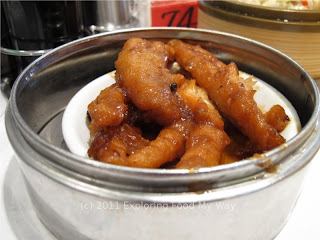
Some at the table absolutely embraced this dish, others categorically refused it. Having never had them, I decided to give them a whirl. The part you actually eat is the flesh around the bones, not the bones themselves. The flesh was soft and came off easily, but the best part was the slightly spicy barbecue sauce that coated the meat itself. Would I order these again? Probably not if I was by myself, but I would eat them again if presented.
Next up at the table were a quartet of steamed pork and shrimp dumplings (shu mai):

This particular dish is very common at Chinese-American buffets for some reason. These were executed at a much higher level than that and had a nice balance between sweet and salt.
Besides starch-based wrappers (such as rice or wheat), another common wrapper for fillings is yuba bean curd. It's the thin skin that forms on tofu when it is made and it makes for a slightly chewy, yet not unpleasant texture, when deep fried:

Stuffed with pork and mushrooms, these were fried to a nice golden brown and served in a brown sauce. They were a little hard to cut, but they were tasty nonetheless.
Since the Chinese don't have the same squeamishness that Americans do when it comes to serving food with the heads on, our plate of Salt and Pepper Shrimp stared back at us as we prepared to dig in:

A simple twist of the head from the body and a quickly peeling of the shell left us with the sweet taste of the shrimp along with a saltiness from the MSG used to prepare the dish. Would I want a whole plate of these? Probably not, but one was perfect.
Next up was a dim sum staple that I've seen at many other restaurants, the Fried Taro Ball:
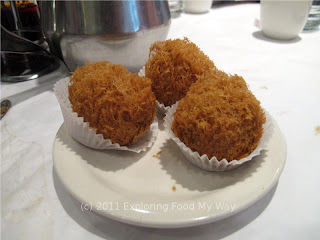
Taro is a starchy vegetable similar to a potato that is used in many other cultures. In this case, the taro has been stuffed with mushrooms, pork, and shrimp, rolled in a breading and then deep fried until crunchy. These were pretty darn good and we even got a bit of amusement as one of the guests at our table commented that they looked like fried Tribbles.
The next dish was the first of two chive and shrimp dumpling dishes, this one heavy on the chives and wok-fried:

These had both the sharp onion bite from the chives and the slight sweetness from the ground shrimp. While not quite as good as the chive potstickers from Wonton Gourmet, these were still pretty darn good and had I not had nineteen other selections from which to choose, I could've eaten all three.
Our only all-meat course for today was half of a roasted duck, chopped into smaller pieces for easier consumption:

The meat was rich and moist and for those willing to eat the skin, a nice bit of fattiness to combat some of the starchiness from the previous dishes. One thing I've learned over the years of eating dim sum is that sometimes (such as when eating the chicken feet), you have to put the chopsticks down and get your fingers a little dirty.
Another dim sum staple, a plate of Turnip Cakes made their way onto our table:

While I enjoyed Li Wah's version, Wonton Gourmet has hands down probably the best turnip cake I've ever tasted. Made with pork sausage, the cakes are first steamed, sliced, and then fried so that the exterior has a nice crunchy exterior. While these were served with a sauce for dipping, I have always preferred mine with a bit of the chile-infused oil that sits on every table.
Next up were shells of green peppers filled with a ground shrimp mixture:

After steaming, the shrimp mousse had set and the final step was to drizzle a savory brown sauce on top. The green pepper is popular in Chinese cuisine as it brings a certain bitterness to the table which the Chinese love.
Next up were rice noodles filled with dried shrimp and then fried:

When I use the word "noodle", think more like enchilada than spaghetti. These were soft and crunchy at the same time. The dried shrimp added a unique fishiness to the dish without being offensive.
Our next finger-licking-good item were bits of beef shortribs:

While there was a significant amount of bone on these that you had to work around, the meat that easily pulled away was tender and spiced with a rich flavor due to the Chinese five spice powder.
Our second chive and shrimp dumpling of the meal came in the form of a steamed rice-paper wrapped version:
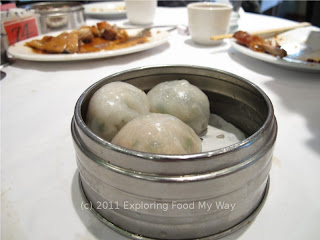
These had more shrimp in them than the first version and thus, were more sweet than sharp. Of course, the steam treatment meant that the wrappers were much more tender than their fried counterpart.
Full yet, gentle reader? I know we were all starting to slow down by this point, but only three dishes remain, so go into power eating (or reading) mode and plow on through to the end!
The next dish was another of Nancy's favorites and was a fried wheat starch dumpling with a pork and shrimp filling:

The interesting thing about this item was that besides being perfectly fried on the outside, the wheat starch just under the fried surface was rather sticky. While this was an unusual texture for an American palate, I didn't find it unappealing at all.
While all of the items we had wanted eventually made their way to us via the carts, there was one particular item that both myself and a fellow tablemate wanted badly enough that we eventually had to ask for several plates of the Steamed BBQ Buns to be brought to the table:
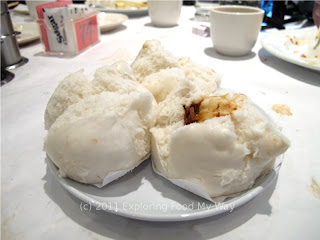
There was a baked version of this available as well, but we wanted this soft and delicate steamed rendition instead. As you can see in the above photo, each bun is sitting atop a square of paper, so do make sure you remove it before eating the bun. As with other dishes today at Li Wah, I've had better versions of the barbecue pork filling elsewhere, but Li Wah's buns were fresh and flavorful. This was definitely the dim sum fix I had been craving.
By this point, I was STUFFED! However, my tablemates decided to add one more item to the table, steamed Chinese broccoli with a Soy/Oyster sauce drizzle:

Much as I needed a wafer-thin mint at this point, I did manage to get a taste in and was delighted to find a vegetable that was cooked through, yet still a bit crunchy. The flavor was only slightly bitter and the savoriness from the sauce went well with the flavor from the broccoli.
Everyone was now in agreement that we were all too full to do any more damage and asked for our check to be tallied. The two-hour epicurean odyssey finally at an end, the bill came to a measly $17.50 per person, tip and tax included. For the level and variety of foods I had eaten today (I pictured eighteen different dishes), this was an unbelievable value. While the restaurant was open and offered dim sum for both lunch and dinner, it is definitely advisable to go for lunch since the dim sum cooks finish up for the day in mid-afternoon and the dishes at night might not be as fresh as they would be during the day.
If the thought of doing dim sum intimidates you, at the end of the day, knowing which dishes to pick is all about what sounds good to you. While I've highlighted eighteen different choices here, there were at least twice as many being offered. I would highly recommend you get yourself to Li Wah and check out the dim sum for yourself. With the ability to customize your meal so completely and for so little money, even if you try a dish you end up not enjoying, there will be plenty more that you will find delicious and satisfying.



